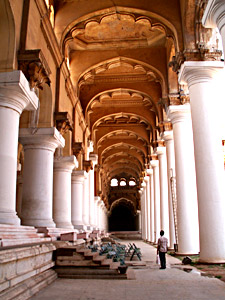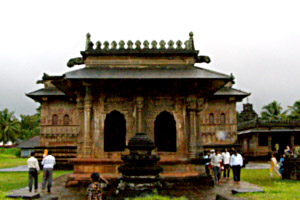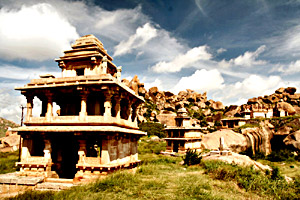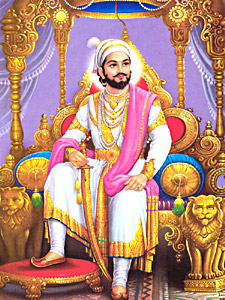 Post the downfall of the great Vijayanagara Empire, military leaders seized the opportunities and took advantages of the ensuing anarchy and established kingdoms of their own. Collectively called the Nayakas (military leaders), the most significant of the band were Nayakas of Tanjore, Nayakas of Chitradurga and Nayakas of Keladi. The Nayakas of Chitradurga dominated upon parts of eastern Karnataka from 1300 to 1779 CE). During the reign of Hoysala Empire and Vijayanagara Empire, the Chitradurga Nayakas functioned as vassals. Later, after the decline of the Vijayanagara empire, they ruled occasionally as an independent kingdom, and in other occasions as vassals of the Mysore Kingdom, Marathas and Mughal Empire. Finally, the Nayakas unified with the province of Mysore during the colonial rule. Owing to such diversified actions, reactions and servings as feudatories, it becomes quite obvious that warfare during Nayaka period was widespread and a commonplace event in Indian ancient history.
Post the downfall of the great Vijayanagara Empire, military leaders seized the opportunities and took advantages of the ensuing anarchy and established kingdoms of their own. Collectively called the Nayakas (military leaders), the most significant of the band were Nayakas of Tanjore, Nayakas of Chitradurga and Nayakas of Keladi. The Nayakas of Chitradurga dominated upon parts of eastern Karnataka from 1300 to 1779 CE). During the reign of Hoysala Empire and Vijayanagara Empire, the Chitradurga Nayakas functioned as vassals. Later, after the decline of the Vijayanagara empire, they ruled occasionally as an independent kingdom, and in other occasions as vassals of the Mysore Kingdom, Marathas and Mughal Empire. Finally, the Nayakas unified with the province of Mysore during the colonial rule. Owing to such diversified actions, reactions and servings as feudatories, it becomes quite obvious that warfare during Nayaka period was widespread and a commonplace event in Indian ancient history.
However, warfare during the Nayaka period cannot be reduced simply to the use of firearms, rather, both the means and the mentalities of the period possessed a broader view. Of the fact that Nayaka armies could be extremely enormous, there lies no room for doubt. When the Dutch factor Carel Reyniersen went to visit the Chandragiri ruler Ramadeva, in October 1629, at his encampment in Tiruttani, he found him with approximately sixty-five thousand men. The later Nayaka campaigns of the 1630s, in the context of the death of Aravidu Timma Raya, usually involved forces ranging from fifteen to twenty thousand. Again, the army on the march of Tirumala Nayaka of Madurai in the 1640s is figured at thirty thousand.
The information available from the seventeenth century on the size of Nayaka armies and warfare during Nayaka period can hence broadly be summed up as follows.
 The bulk of the Nayaka forces prepared at war, were made up of infantry and they comprised poorly-armed peasant-warriors for the most part. A basis factor acting here is that, owing to being too early in time and being a clandestine group, Indian history finds little mention about the Nayaka art of warfare. Sharing of information was not a custom in vogue during those days. Cavalry contingents are as such harder to estimate, for none of the Nayakas truly had a standing army worth speaking of. The Bijapuri cavalry in the late 1640s numbered roughly to seventeen thousand and they were sufficient to carry every other before it. Hence, information can be gathered and some impression of the order of magnitude of cavalry that each of the Nayakas could muster is also available.
The bulk of the Nayaka forces prepared at war, were made up of infantry and they comprised poorly-armed peasant-warriors for the most part. A basis factor acting here is that, owing to being too early in time and being a clandestine group, Indian history finds little mention about the Nayaka art of warfare. Sharing of information was not a custom in vogue during those days. Cavalry contingents are as such harder to estimate, for none of the Nayakas truly had a standing army worth speaking of. The Bijapuri cavalry in the late 1640s numbered roughly to seventeen thousand and they were sufficient to carry every other before it. Hence, information can be gathered and some impression of the order of magnitude of cavalry that each of the Nayakas could muster is also available.
An examination of the extant descriptions of wars and campaigns in the Nayaka period suggests that three elements played a crucial role in determining the course of military engagements. Warfare during Nayaka period firstly involved the intelligent use of terrain. The victors in sixteenth and seventh century wars in peninsular India were often those who, like the Maravas, Kallars and Kodavas, practised what perhaps would be termed `guerrilla tactics`. A second aspect of importance is the role played by sedition and negotiation, particularly in the context of fortified positions which were in fact impregnable in a wholly military sense. Related to this, is the issue of the control of the fortified, central place, as distinct from the control of the `field` or countryside, from which revenues were drawn. The third element that needs to be considered, particularly on the Coromandel plain, is that of `mobility` and it is here that the Nayaka cavalry played such a decisive role.
But it is the first of these redefining Nayaka roles that draws attention to the wider geopolitical context. And here, the frontier between Tanjavur and the Marava country provides information with particularly crucial illustrations. Both during the period of the Nayakas and later, during the reign at Tanjavur of the Maratha dynasty, combating the Marava Setupatis proved a major problem for their northern neighbours. Indeed, the Maravar connection helps explain, to no small degree, the final disintegration of the Nayaka state of Tanjavur. It also appears that the art of warfare during Nayaka period was not much a masterwork, leading to massive breakdown and tumbling; powerful Marathas had come up to take the place. There is a general issue here relating to the role of the smaller, more peripheral political entities, such as Ramnad and the Kajlar rajas of Pudukkottai.
 Nayaka state-system, in particular in terms of the balance of power were also unique by their own right. Historical observers were well aware of the crucial role played by these mini-states. Thus, ancient writers, as early as 1656 have written about the Marava Setupati as `the chief of a warlike race which has been so emboldened by its successes that even now it is to be reckoned with by European powers`. If at times the Maravar allied themselves with the Madurai Nayakas (as during the campaign against Mysore in 1655-56), on other occasions they were a thorn in the flesh of the Madurai and Tanjavur rulers. Warfare during Nayaka period were assorted as could be humanly possible, with popping instances of one bright spot. Where Kauar power was concerned, the Madurai kingdom provides with numerous instances of its potentially destabilising character. At a literary level, works such as the well-known Maturaiviracuvamikatai, the hero of which is hired by Tirumala Nayaka of Madurai to protect the market-place of his capital-town from the Kalars, confirm the contemporary Jesuit sources. These sources sometimes speak of devastating Kajjar raids in the 1650s and 1660s on Madurai, Tanjavur and Tiruchirappalli.
Nayaka state-system, in particular in terms of the balance of power were also unique by their own right. Historical observers were well aware of the crucial role played by these mini-states. Thus, ancient writers, as early as 1656 have written about the Marava Setupati as `the chief of a warlike race which has been so emboldened by its successes that even now it is to be reckoned with by European powers`. If at times the Maravar allied themselves with the Madurai Nayakas (as during the campaign against Mysore in 1655-56), on other occasions they were a thorn in the flesh of the Madurai and Tanjavur rulers. Warfare during Nayaka period were assorted as could be humanly possible, with popping instances of one bright spot. Where Kauar power was concerned, the Madurai kingdom provides with numerous instances of its potentially destabilising character. At a literary level, works such as the well-known Maturaiviracuvamikatai, the hero of which is hired by Tirumala Nayaka of Madurai to protect the market-place of his capital-town from the Kalars, confirm the contemporary Jesuit sources. These sources sometimes speak of devastating Kajjar raids in the 1650s and 1660s on Madurai, Tanjavur and Tiruchirappalli.
Warfare during Nayaka period makes itself even more interesting when it is noticed that they had metamorphosed gradually, with visible effects. Much of this `apparent anarchy` can be explained in terms of a sort of `internal frontier`, which existed in the Nayaka political universe. The Kallars, Maravas and other Nayaka groups which laid claim to kaval dues (a term that appears in contemporary Portuguese as vigia and in Dutch as visie), inhabited the interstices of the Nayaka system. These groups were hence `co-sharers of the realm`, to borrow a phrase current in eighteenth-century Maratha history. The Nayaka periphery deserves attention in its own right; at this point it is noted that by the second half of the seventeenth century, a complex and delicate loop of alliances held the tattered system together. And the smaller units from the middle levels were, in many ways, key elements in this equation, primarily as factors of dangerous disruption.
 Warfare during the Nayaka period can therefore be seen as representing a moment of transition, with new elements entering the system, but still imperfectly incorporated within it. Many of the features that have been seen as characteristic of eighteenth-century warfare in peninsular India can be found, moreover, in embryonic form in this epoch. Some of the principal features include the use of firearms, the shift toward a higher proportion of cavalry to infantry, the use of mercenaries and so on. However, the situation is not entirely convincing that the desired transitions in the modes of conducting war took place painlessly, or without complex adjustments, both at the level of logistics and of mental structures. In the final analysis, Nayaka warfare remained largely infantry-based and adopted two basic forms. One centred around the relative strengths of those who controlled massively-fortified central places as compared to those who held control of trade routes and agrarian surplus. And it was in this respect that the forces of Bijapur and Golconda, with their greater use of cavalry, eventually overmastered the Nayakas. The other form involved the tactical use of terrain, forest cover and ambush and here groups like the Kallars and Maravas remained masters well into the eighteenth century.
Warfare during the Nayaka period can therefore be seen as representing a moment of transition, with new elements entering the system, but still imperfectly incorporated within it. Many of the features that have been seen as characteristic of eighteenth-century warfare in peninsular India can be found, moreover, in embryonic form in this epoch. Some of the principal features include the use of firearms, the shift toward a higher proportion of cavalry to infantry, the use of mercenaries and so on. However, the situation is not entirely convincing that the desired transitions in the modes of conducting war took place painlessly, or without complex adjustments, both at the level of logistics and of mental structures. In the final analysis, Nayaka warfare remained largely infantry-based and adopted two basic forms. One centred around the relative strengths of those who controlled massively-fortified central places as compared to those who held control of trade routes and agrarian surplus. And it was in this respect that the forces of Bijapur and Golconda, with their greater use of cavalry, eventually overmastered the Nayakas. The other form involved the tactical use of terrain, forest cover and ambush and here groups like the Kallars and Maravas remained masters well into the eighteenth century.
Historians of the eighteenth century have frequently put forward that warfare destroyed the economy of Tamil Nadu in the period. This would suggest a contrast with the earlier two centuries, when the sheer numerical frequency of `campaigns` bore no real relationship to the effects that these had on production, trade or welfare. An examination of the history of the Maratha dynasty at Tanjavur suggests that warfare in the region continued until the mid-eighteenth century to exhibit many of the characteristics of the Nayaka period, with armies being smaller in size than before. Warfare during Nayaka period had curiously been successful to influence later realms and their combatting art. The Tanjavur Raja Pratapasimha commanded a force of approximately eight thousand horse and perhaps twice that number of infantry, mostly being inspired from the Nayakas.
All this was to change, however, in the late eighteenth century, when warfare became far more brutal and aimed at damaging the economic machine of the opponent. War no longer merely stood for taking over the country, as with the Madurai Nayakas and Marava Setupatis in their attacks on Tanjavur during the 1670. To illustrate further, in their campaigns of the 1780s, the English Company and the Mysore rulers attacked the irrigation system, deported men and cattle in large numbers and set a new standard for the conduct of war in the area. If a `military revolution` in the history of peninsular Indian warfare is sought, it is probably more appropriate to locate it in this later period than in the epoch of the Nayakas. Warfare during Nayaka period had paved way for a different kind of battle, more prevalent in contemporary times. There always existed a fascination for the Nayakas with technological innovation, so very evident in the literary sources. During the Nayaka period, a sense of a very real expansion in means and knowledge could also be witnessed. Yet, the very slowness and unevenness of the transformation under the Nayakas and their successors suggest that changes in the art of war in this period cannot easily be accommodated to the dramatic framework of a `revolutionary` shift.



















